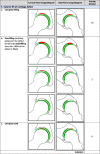Defining hip cartilage repair: a modified delphi study to establish the Magnetic Resonance Evaluation of the Repair of Cartilage in the Hip (MERCH) score
- PMID: 38051413
- PMCID: PMC10697921
- DOI: 10.1186/s40634-023-00676-y
Defining hip cartilage repair: a modified delphi study to establish the Magnetic Resonance Evaluation of the Repair of Cartilage in the Hip (MERCH) score
Abstract
Purpose: To develop a standardized scoring system to evaluate pre- to post-operative repair or reconstruction of hip cartilage using magnetic resonance imaging (MRI).
Methods: A two-phase modified Delphi study was conducted. Phase 1 involved a survey with suggested criteria and diagrams to define various stages of articular cartilage repair and phase 2 involved an expert consensus meeting that discussed the survey responses and voted on final scoring criteria. The survey was emailed to members of the Canadian Hip Preservation Research Collaborative (CHIPR) and respondents included both board certified orthopedic surgeons as well as musculoskeletal radiologists.
Results: Overall, there were 17 survey respondents from Canada and most (47%, 8/17) participants agreed that the minimum MRI protocol needed to evaluate cartilage repair was a 3.0 T MRI and 94% (17/18) agreed that the minimum time post-operatively that they felt they would be able to accurately evaluate cartilage repair on an MRI was 12 months. Following phases 1 and 2, the final Magnetic Resonance Evaluation of the Repair of Cartilage in the Hip (MERCH) score was developed with 7 domains, 3 criteria per domain: 1) volume fill of cartilage defect, 2) integration into adjacent cartilage, 3) surface of the repair tissue, 4) structure of the repair tissue, 5) bony overgrowth, 6) subchondral changes, and 7) delamination. The score ranges from 60 (optimal) to -20 points (worst/none).
Conclusions: This consensus project established a new MRI scoring system to evaluate post-operative cartilage restoration of the hip. The implementation of the MERCH score is essential in our ability to guide patient management and expectations in a rapidly evolving field and will help with standardizing our evaluation of cartilage repair in future research trials.
Level of evidence: Level II Diagnostic.
Keywords: Cartilage; Hip; MRI; Reconstruction; Repair.
© 2023. The Author(s).
Conflict of interest statement
ORA is funded in part by a Tier 2 Canada Research Chair in Joint Preservation Surgery, and is the Editor-In-Chief of the Journal of ISAKOS. NS is the Managing Editor of the Journal of ISAKOS.
Figures
Similar articles
-
The MOCART (Magnetic Resonance Observation of Cartilage Repair Tissue) 2.0 Knee Score and Atlas.Cartilage. 2021 Dec;13(1_suppl):571S-587S. doi: 10.1177/1947603519865308. Epub 2019 Aug 17. Cartilage. 2021. PMID: 31422674 Free PMC article.
-
Injectable autologous chondrocyte implantation in acetabular cartilage defects: 2-year minimum clinical and MRI results.Arch Orthop Trauma Surg. 2023 Feb;143(2):739-747. doi: 10.1007/s00402-021-04141-2. Epub 2021 Sep 1. Arch Orthop Trauma Surg. 2023. PMID: 34468836
-
Experimental scoring systems for macroscopic articular cartilage repair correlate with the MOCART score assessed by a high-field MRI at 9.4 T--comparative evaluation of five macroscopic scoring systems in a large animal cartilage defect model.Osteoarthritis Cartilage. 2012 Sep;20(9):1046-55. doi: 10.1016/j.joca.2012.05.010. Epub 2012 Jun 12. Osteoarthritis Cartilage. 2012. PMID: 22698442
-
Autologous tissue transplantations for osteochondral repair.Dan Med J. 2016 Apr;63(4):B5236. Dan Med J. 2016. PMID: 27034191 Review.
-
Diagnosing Hip Microinstability: an international consensus study using the Delphi methodology.Knee Surg Sports Traumatol Arthrosc. 2023 Jan;31(1):40-49. doi: 10.1007/s00167-022-06933-4. Epub 2022 Apr 30. Knee Surg Sports Traumatol Arthrosc. 2023. PMID: 35499620 Free PMC article. Review.
Cited by
-
What the papers say.J Hip Preserv Surg. 2024 Apr 9;11(1):80-82. doi: 10.1093/jhps/hnae005. eCollection 2024 Jan. J Hip Preserv Surg. 2024. PMID: 38606326 Free PMC article. No abstract available.
References
-
- Bettuzzi C, Abati CN, Salvatori G, Zanardi A, Lampasi M. Interobserver reliability of Diméglio and Pirani score and their subcomponents in the evaluation of idiopathic clubfoot in a clinical setting: a need for improved scoring systems. J Child Orthop. 2019;13(5):478–485. doi: 10.1302/1863-2548.13.190010. - DOI - PMC - PubMed
-
- Buckwalter JA, Mankin HJ. Articular cartilage: degeneration and osteoarthritis, repair, regeneration, and transplantation. Instr Course Lect. 1998;47:487–504. - PubMed
LinkOut - more resources
Full Text Sources
Research Materials



